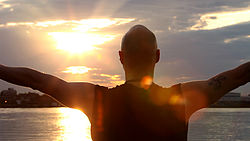
| Part of a series on |
| Alternative medicine |
|---|
 |
Sungazing is the practice of intentionally looking directly at the sun, usually during sunrise or sunset. Proponents believe it can provide health benefits by connecting with the sun's energy, potentially leading to increased energy levels, improved mental clarity, and even spiritual awakening. However, medical professionals strongly advise against it due to the risk of severe eye damage.[1] The human eye is very sensitive, and exposure to direct sunlight can lead to solar retinopathy, pterygium,[2] cataracts,[3] and potentially blindness.[4][5][6] Studies have shown that even when viewing a solar eclipse the eye can still be exposed to harmful levels of ultraviolet radiation.[7]
Damage
[edit]The damage to eyes from ultraviolet radiation can be serious and permanent due to damage to the retina. Wearing sunglasses can prevent some harm, depending on the UV rating.[8] People who have had cataract surgery, received photodynamic therapy, or are under the effects of photosensitizing medications have an increased risk of eye damage due to sungazing. During a solar eclipse, the risk of damage is especially high. When looking at the eclipsed Sun directly, the eyes dilate due to the reduced visible light. Without proper protection, this leads to a larger area for the Sun's UV rays to penetrate and do damage. This can be hard to prevent as the retina has no pain receptors.[9][10]
Movements
[edit]Referred to as sunning by William Horatio Bates as one of a series of exercises included in his Bates method, it became a popular form of alternative therapy in the early 20th century.[11] His methods were widely debated at the time but ultimately discredited for lack of scientific rigor. The British Medical Journal reported in 1967 that "Bates (1920) advocated prolonged sun-gazing as the treatment of myopia, with disastrous results".[12]
See also
[edit]References
[edit]- ^ Liberatore, Paul (2009-09-30). "Mill Valley man's film on people who stare at the sun among featured at festival". Marin Independent Journal. Archived from the original on 2009-10-05. Retrieved 2009-10-17.
- ^ Solomon, A S (2006). "Pterygium". British Journal of Ophthalmology. 90 (6): 665–6. doi:10.1136/bjo.2006.091413. PMC 1860212. PMID 16714259.
- ^ Neale, Rachel E.; Purdie, Jennifer L.; Hirst, Lawrence W.; Green, Adèle C. (2003). "Sun Exposure as a Risk Factor for Nuclear Cataract". Epidemiology. 14 (6): 707–12. doi:10.1097/01.ede.0000086881.84657.98. PMID 14569187. S2CID 40041207.
- ^ Stokkermans TJ, Dunbar MT (Oct 1998). "Solar retinopathy in a hospital-based primary care clinic". J Am Optom Assoc. 69 (10): 625–36. PMID 9805443.
- ^ D van Norren (October 1, 1991). "Photochemical Damage to the Eye". News Physiol Sci. 6 (6): 232–234. 1548-9213/91.
- ^ Chen JC, Lee LR (November 2004). "Solar retinopathy and associated optical coherence tomography findings" (PDF). Clin Exp Optom. 87 (6): 390–3. doi:10.1111/j.1444-0938.2004.tb03100.x. PMID 15575813.
- ^ Krasniz I, Beiran I, Miller B (1999-11-01). "Retinal lesion due to excessive exposure to sunlight". Harefuah. 137 (9): 378–80, 431, 430. PMID 11419039.
- ^ Turbert, David (29 May 2024). "The Sun, UV Light and Your Eyes". www.aao.org. Retrieved 11 June 2024.
- ^ "Eclipse Viewing Safety". science.nasa.gov. 24 February 2022. Retrieved 11 June 2024.
- ^ "2024 Solar Eclipse". www.urmc.rochester.edu. Retrieved 11 June 2024.
- ^ Chou, Brian (15 September 2004). "Exposing the Secrets of Fringe Eye Care". Review of Optometry. 141 (9). Archived from the original on 13 December 2013. Retrieved 1 May 2011.
- ^ Ridgway, A. E. (1967). "Solar retinopathy". BMJ. 3 (5559): 212–4. doi:10.1136/bmj.3.5559.212. PMC 1842517. PMID 6028468.